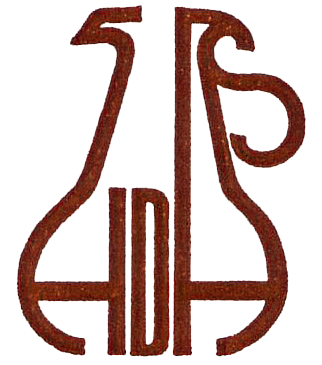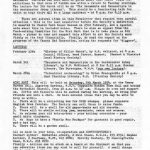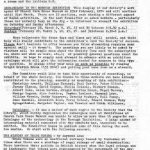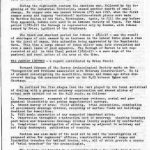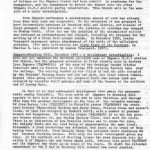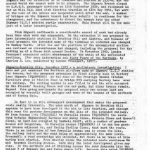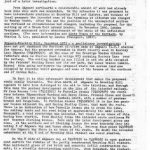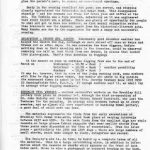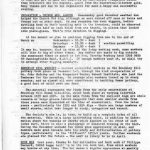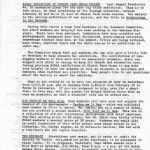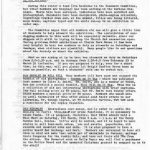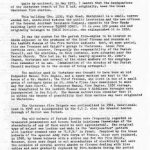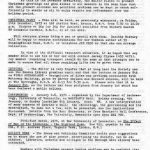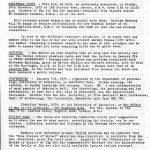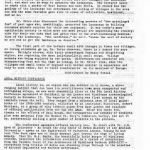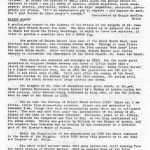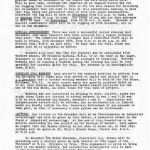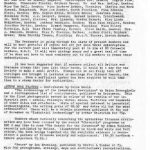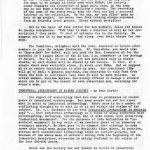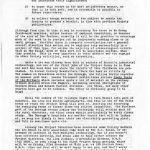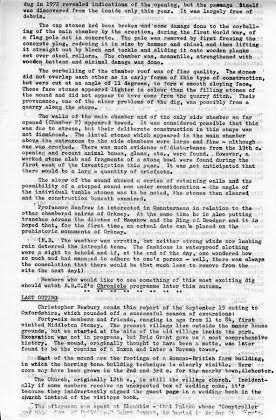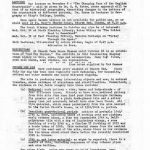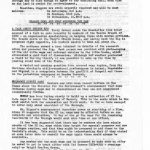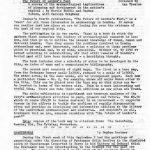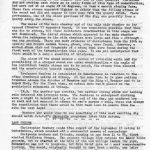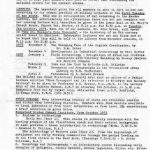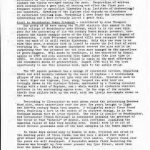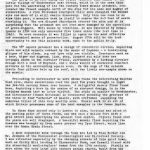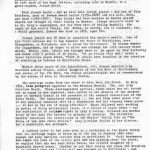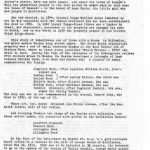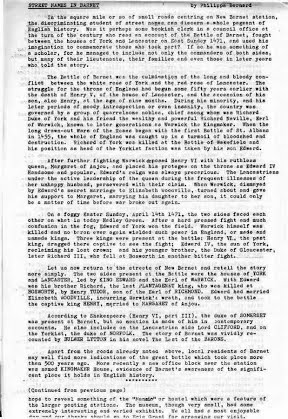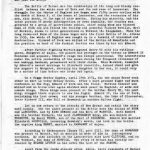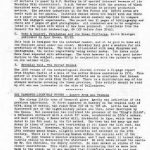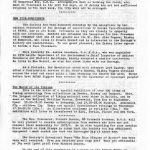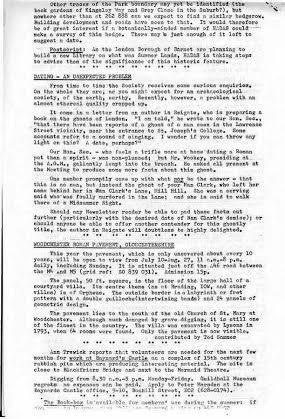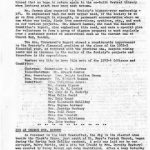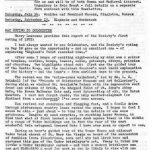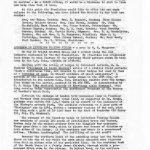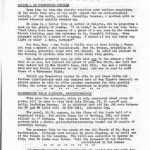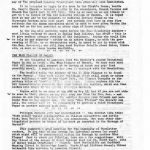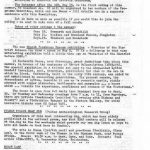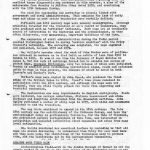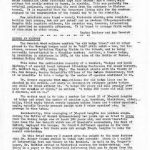Page 1
The Editor offers apologies to all members who have suffered altered dates and venues for lectures recently. It has been impossible to give adequate notice on many occasions, since we ourselves were subjected to last-minute instructions. However, one of our problems has been solved — the Library at The Burroughs is at last free from the builders. Lectures can once more be given under that roof. Power restrictions in the area of Hendon now allow a return to Tuesday evenings. The lecture for 5 March will be on “The Documents and Manuscripts in the Westminster Abbey Library”. This should be a fascinating talk for which we hope there will be a large audience — at 8.00p.m. for 8.15p.m.
There are several items in this Newsletter that require very careful attention — this is the last newsletter before the Society’s Exhibition is mounted at Church Farm House Museum on 23 February, and a special note about this is included below. There is also an Appeal from the Fund-raising Committee for the Mini Mart that is to take place on 6 March — please do come and support this effort to set the Society more firmly on its feet financially. Finally, do read the report on the progress of the Church End Excavation, noting the requests for “diggers”.
Lectures
February 13th. — “History of Pillar Boxes”, by W. R. Wellsted, at 8.00p.m. — Council Offices, Wood Street, Barnet. (Barnet and District Local History Society)
5 March — “Documents and Manuscripts in the Westminster Abbey Library”, N. H. McMichael at 8.00 for 8.15p.m. Hendon Library, The Burroughs, NW4 (our own lecture).
28 March — “Industrial Archaeology” Brian Bracegirdle at 8.00p.m. East Finchley Library, N2 (Finchley Society)
MINI MART
This will be held on Saturday 9 March 1974, at the Henry Burden Hall, Edgerton Gardens, NW4 (opposite Hendon Town Hall and behind the Methodist Church), from 10.00a.m.-12.00. Please do come and support us. Coffee and biscuits will be served during the morning, so bring your friends and have a chat. We have several ideas that you may be able to help us with: —
1. There will be a collecting box for USED stamps; please separate English from foreign. The Society can sell these to raise funds.
2. There will be a stall for old paper-backs and old records.
3. There will be stalls selling jam, marmalade, cakes and scones.
4. We welcome your old bric-a-brac — your holiday souvenirs — your small white elephants.
5. We hope to have a “Nearly New Boutique” for garments in good repair, and a hat bar.
6. There will be a garden stall.
All we need is your help, co-operation and CONTRIBUTIONS!!
Contact either: Christine Arnott, Daphne Lorimer or Dorothy Newbury.
Finally — notices can be stuck on a board at the Minimart so that you can advertise items you may wish to sell for yourself. A small charge will be made for this service.
Excavation, Church End, Hendon
SOS, SOS, SOS. We need your help if we are to complete this excavation. Weather permitting, digging takes place on Wednesdays from 10.30a.m. to dusk and on Saturdays and Sundays from 10.00a.m. to dusk. Ted Sammes reports that much of interest is coming to light and making the possibility of Saxon Hendon a reality…
Roman — three sherds of possible Roman origin, but we still need to find more before we can claim Roman settlement on the spot.
Late Saxon — we have the beginnings of a ditch system cut into the natural clay of the area. These Roman ditches are producing animal bones and, more importantly, late Saxon grass-tempered pottery sherds, dated by experts to 700-1050 AD.
Page 2
Post-Medieval period — this has also received a numismatic boost in the shape of a second silver penny. This was found in the house area, and after cleaning was identified as a base penny of Henry VIII, part of the posthumous coinage of 1549-50, minted at Canterbury. We also have a merchant’s bail sale in lead, and a quantity of pins, probably hand-made.
For the eighteenth century, bottle bases, tops and pipe-bowls continue to be found, and we have one very nice seal from a glass bottle marked with a Crown and the initials G.R.
Archaeology in the Borough Exhibition
This display of our Society’s work opens at Church Farm House Museum on 23rd February 1974 and will continue until 31st March. There are fifteen sections, each showing a different aspect of HADAS activities. In the last newsletter we are asked members — particularly those not normally busy on the dig — to volunteer to steward the exhibition on Saturday and Sunday afternoons:
Saturdays (February 23rd, March 2nd, 9th, 16th, 23rd and 30th between 2.00-5.30p.m.)
Sundays (February 24th, March 3rd, 10th, 17th, 24th and 31st between 2.30-6.00p.m.)
More volunteers for these days and times are still needed, and their help will really contribute to the exhibition’s (and the Society’s) success. Please don’t hesitate to offer because you think stewarding requires some special skill — it doesn’t. The questions you are likely to be asked by visitors will be simple ones about the Society (how much the subscription is, where and when we meet, etc); or possibly general questions about the exhibits. We hope to supply each steward in advance with an Exhibition Catalogue which will give the information needed for answers to this type of question. So please offer your help as soon as possible by ringing Bridgid Grafton Green and putting your name down as a steward.
The committee would like to take this opportunity of recording, on behalf of the whole society, its thanks to those members who have already contributed to the planning, assembly or mounting of this exhibition: —
Christine Arnott, Philippa Bernard, Paul Carter, Peter Clinch, Jeremy Clynes, David Cogman, Stella Colwell, Richard Deacon, Albert Dean, Helen Gordon, Brigid Grafton Green, Nigel Harvey, George Ingram, Alec Jeakins, Daphne Lorimer, Raymond Lowe, William Morris, Paddy Musgrove, Dorothy Newbury, Nell Penny, Anne Randall, Elizabeth Read, Percy Reboul, Edward Sammes, Mary Spiegelhalter, Margaret Taylor, Ann Trewick and Freda Wilkinson.
Catalogue — It was a matter of much regret to the Society that the Library, which kindly duplicates the Catalogues used at Exhibitions at Church Farm House Museum was unable to allow us more than sixteen pages for our Catalogue of the Archaeology in the Borough Exhibition. A large amount of interesting material connected with the exhibits had, therefore, to be omitted. The Newsletter hopes to publish some of this during the next few months. We start with the following account.
The History of Trade Tokens – by Raymond Lowe
Trade tokens were an unofficial currency issued by tradesmen at times when there was a shortage of regal coinage of small denomination. There have been three periods in British history when the legal coinage was so inadequate that tokens were countenanced by the government of the day: 1648-72; 1787-97; 1811-17.
The prosperity of the first Elizabethan age caused farmers and landowners to pay more of their workers in coin instead of, as hitherto, in kind. At this time, however, the mint struck only gold and silver pieces. To overcome the lack of small change, James I granted patents to his favourites, Torrington and Lennox to issue farthings. Charles I continued this practise with the issue of Richmond, Maltravers and rose farthings. Under this system the profit, instead of going to the people, was shared by the King and the patentee.
Page 3
In 1643 a regal coinage was agreed upon, but the Civil War, the execution of the king in 1649 and the rule of the Commonwealth deferred the scheme till 1672. In the 24 years before that an estimated 12,000 types of trade token were issued. They consisted of pennies, half-pennies and farthings, made of brass or copper — hence the term “a brass farthing”. The dies for these coins were mostly made by David Ramage of London. Over 20 tokens are known for this period in the Borough: Hendon (2), Finchley (2), Whetstone (2) and Barnet (15).
During the eighteenth century the American War, followed by the beginning of the Industrial Revolution, caused another dearth of small change. No copper coinage was issued between 1775 and 1797, when the first copper penny and tuppeny “cartwheel” machine-struck pieces were made by Matthew Bolton at the Mint, Birmingham. Again, to fill the gap before they appeared, tokens were used in an immense variety of types. For this period (1787-97) the Borough is represented only by Hendon, with tokens issued by Price, landlord of the Greyhound.
The third and shortest period for tokens – 1811-17 — was the result of shortages of coin caused by an increase in the labour force plus a rise in the level of wages, this situation being aggravated by the Napoleonic Wars. This time a large amount of token silver came into circulation and even a small issue of gold appeared. The Borough of Barnet is not represented at all in this final period (1811-17) — a sure sign of the pastoral and the rural nature of the area at the time.
The January Lecture
A report contributed by Brian Favell.
Bernard Johnson of the Surrey Archaeological Society spoke on the “Recognition and Problems associated with Motorway Construction”. He is at present investigating the mesolithic, bronze and Roman age sites discovered during the construction work on of the M25 between Egham and Chertsey.
He outlined the five stages (and the part played by the local societies) of dealing her with a proposed motorway construction and showed slides of actual work carried out on the M25 route, as follows:
1. Reconnaissance: research of documentary evidence, aerial and geophysical (resistivity and proton magnetometer) surveys.
2. Ground survey of area: field walking, trial excavations, examination of preliminary drainage ditches, recording of surface finds and buildings destined for demolition.
3. Full-scale excavation of any suspected important sites.
4. Observation throughout construction work of motorway: checking boundary post holes and transverse drainage ditches (kindly supplied by contractor).
5. Conclusion: investigation of sites shown up adjacent to motorway and not fully destroyed; publication of results.
Mention was also made of the need not to omit the investigation of prepared sites for engineers’ offices, construction workers’ camps and foundation trenches for ballast trains, etc., all of which provide a source of “trial trenches” for the archaeologists.
The lecture was brought to a conclusion with a few words from Harvey Sheldon on the differences between the previous or “rural” problems and his own “urban” problems in London, for example cellar building and man-made level changes destroy the natural stratifications. Ann Trewick gave a vote of thanks to both speakers for the insight they had given into the trials and tribulations encountered in both rural and urban archaeology; Hendon, she added, had its share of both!
The Railway that never was
Paul Carter contributes this — the first instalment. ) Edgware-Aldenham: a brief history. Shortly after being set up in 1933, the London Passenger Transport Board announced its 1935-40 New Works Programme. This included in the North London Scheme, part of which proposed the building of a tube link between Archway (on the Hampstead tube) and East Finchley (L.N.E.R); the electrification for tube train working of the L.N.E.R. branches from East Finchley to High Barnet and to Edgware; and the construction of an extension from Edgware northwards to Aldenham.
Page 4
The tube link from Archway to East Finchley was brought into use on 3rd July 1939 and the line from East Finchley to a High Barnet opened to electric tube train working on 14 April 1940. Work on the other part of the scheme, with electrification from Finchley Central through to Edgware and the extension on to Aldenham had started in 1937-8, but the second World War caused work to be stopped. The Edgware Branch closed to L.N.E.R. passenger services on 11 September 1939, and reopened as far as Mill Hill East with electric traction on 18 May 1941, but work on the rest of the scheme was suspended until after the war. A number of bridges on the Edgware branch had been rebuilt in readiness for the changeover, and the embankment to divert the branch into the other Edgware (L.T.) Station partly constructed. This branch will be the subject of a later investigation.
From Edgware northwards a considerable amount of work had already been done when work was suspended. On the extension it was proposed to have intermediate stations at Brockley Hill and Elstree, and because of local pressure the intended name of the terminus at Aldenham was changed to Bushey Heath. After the war the position of the uncompleted section was reviewed as circumstance had changed, including the proposal for the setting up of a Green Belt around London. In November 1950, London Transport announced entire abandonment of the whole of the unfinished sections. (For more information see “Sixty years of the Northern”, by Charles E. Lee, published by London transport, 1967.)
Edgware-Brockley Hill, December 1973- a preliminary investigation;
I have not yet examined the northern platform ends at Edgware (L.T.) Station for traces, but the proposed extension is first clearly seen in Rectory Lane Edgware (TQ194920); at the rear of the Prestige Wooden Kitchen Furniture shop in Station Road is bridge NT3 carrying Rectory Lane over the railway. The cutting beyond is now filled in and the site occupied by the Friends’ Meeting House and its car park, but clear traces remain. Beyond this going northwards the proposed route ran across land now occupied by recently built garages and some of the houses at the northern end of Herons Gate.
In fact it is this subsequent development that makes the proposed route easily traceable. The area north of Edgware to Brockley Hill appears to have been developed in the mid to late ’30s, and through this runs the postwar development of the line of intended railway. NW from Herons Gate (TQ193291) to Purcells Avenue (TQ192924) the route runs between Edgwarebury Gardens and Savoy Close, Princes Close and Queen’s Close, on land now occupied by Campbell Croft, with a number of postwar houses and bungalows. In Purcells Avenue(TQ192924) it is the two postwar houses adjacent to, and facing Shelley Close, that mark the route. There is no indication of how Purcells Avenue was to cross the line, the railway route and the road being at approximately the same level. Presumably a road overbridge was intended, but there is no trace of this having been started. From Shelley Close the intended route continues NW and becomes Sterling Avenue. Here only the later development gives any clue. At the northern end of Sterling Avenue the road descends into the valley south of Edgware Way and turns sharp left. Between this point(TQ188928) and the Edgware Way there is no trace of the route. No doubt the intended embankment at the South end of Brockley Hill viaduct was never started.
On the north side of Edgware Way at TQ187930 to TQ186923 in open pasture land survive the remains of the partly constructed Brockley Hill viaduct. Nine half-built piers of red brick and concrete infill construction remain, in a steadily deteriorating condition. When finished, the viaduct of a brick and plate girder construction, would have been 530 yd long, and would have carried the railway across Edgware Way through the proposed Brockley Hill Station. A short distance to the northwest at TQ185933 are traces of a partly constructed embankment to bring the railway down off the viaduct. The route from here to Aldenham will be described in Part 2 of this report.
